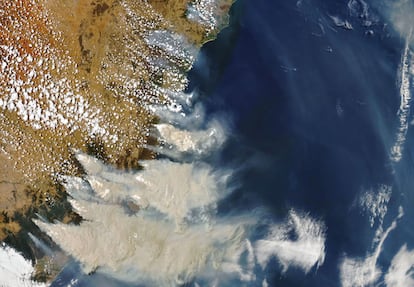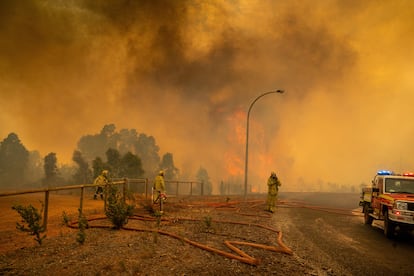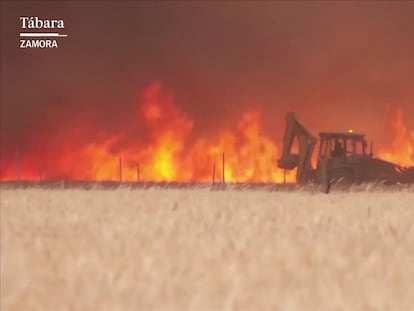Wildfire smoke reopens the hole in the ozone layer
The fires that ravaged Australia in 2020 weakened the filter that protects the Earth from solar radiation

Life on Earth takes place in the troposphere, the lower layer of the atmosphere that is abundant in oxygen (O2), which living beings breathe. Above it is the stratosphere, rich in ozone (O3), which acts as a filter for ultraviolet radiation. Life below would simply not be possible without this compound. Now, a group of scientists has discovered that the smoke from wildfires is combining with other human-generated gases to destroy this ozone. Following the 2019-20 summer bushfires in Australia, the hole in this filter grew 10%. As a global phenomenon, the megafires in California, northern Canada, Chile, the Indonesian jungles, Siberia or the Mediterranean would be weakening the atmospheric protection that makes this planet a good place to live.
Throughout the geological evolution of the Earth – perhaps by simple chance – a mechanism emerged that protects the planet from ultraviolet (UV) rays, especially those of type B and C, which have the greatest potential for cellular and genetic damage. This mechanism, in its simplified version, involves molecules of oxygen (O₂, formed by two oxygen atoms, O). Exposure to UV radiation breaks down the O₂ molecules into O atoms, which then join other O₂ molecules to form O₃, that is, ozone. Its molecules absorb solar radiation until they wear out, decompose into oxygen and start again. This is how it has been for millions of years. But then, a century ago, engineers from General Motors and Du Pont created a gas they called Freon, and what had been working for millions of years went downhill in the blink of an eye.
Freon was the first of the many chlorofluorocarbons (CFCs) on which the democratization of refrigerators was based first, and that of air conditioning and spray cans later. Several decades later, in 1974, Mexican scientist Mario Molina proved that CFCs were rising to the stratosphere and making a hole in the ozone layer. Under the action of radiation, the chlorine in these gases becomes highly reactive and, in a geometric progression, decomposes the ozone into oxygen. The fear was such, that in 1987 the Montreal protocol banned the use of CFCs. The bad news is that they remain in the stratosphere for decades. The good news, though, is that five years ago the ozone layer was reported to be recovering. However, the fires could make this recovery go up in smoke.

In 2020, after years of healing, the Antarctic ozone hole weakened like never before. Most scientists considered it to be the exception to the trend. However, Susan Solomon, an atmospheric chemist at the Massachusetts Institute of Technology (MIT), as well as other colleagues, did not agree with that assumption. At the same time that stratospheric ozone depletion was taking place in most of the southern hemisphere, there were unusually low levels of hydrochloric acid and historically high levels of chlorine monoxide.
The hydrochloric acid (HCl) that is present in the stratosphere comes from the breakdown of CFCs that humans have emitted for nearly a century. In principle, the chlorine it contains is not reactive, unless it is released and, in contact with oxygen, becomes chlorine monoxide, the true killer of ozone. Until now it was known that HCl interacted with cloud particles and radiation, breaking down into chlorine monoxide (ClO₂) or atomic chlorine (Cl). Before these revert to hydrochloric acid, they will destroy 1,000 ozone molecules. But such a reaction occurred under thermal and radiation conditions whose optimal level occurs in the stratosphere of the polar regions. That is why the hole in the ozone layer opens over the Antarctic and occasionally the Arctic, but not the rest of the planet. However, now it is deteriorating over other parts of the globe as well, Solomon and colleagues report in the journal Nature.
The fact that the HCl dropped to unprecedented levels in the mid-latitudes was a warning to Solomon that something serious was going on. The chemical levels in the stratosphere did not add up. An element was missing from the equation, and they thought that the answer could be hiding in the smoke from the fires. In the months immediately preceding the annual depletion of the ozone layer, Australia went through a horrifying wave of fires that devastated 30 million hectares, killing more than a billion living things and spewing close to a million tons of smoke into the atmosphere. These particles, thirty kilometers high, were rich in organic carbon. In principle, carbon is not reactive.
“It is a brutal shock for scientists who study the stratosphere. No one expected the fires to produce such an effect.”Susan Solomon, atmospheric chemist from the Massachussets Institute of Technology (MIT).
After searching in chemistry books and studies, they found out that the hydrochloric acid from CFCs is soluble in a wide variety of carbon-based organic compounds and, what is worse, at temperatures that occur in the stratosphere of the middle latitudes. The pieces were beginning to fit together.
A global problem
Organic carbon ends up in compounds like alcohols and organic acids. The organic acids and alcohols in the particles cause them to react with hydrochloric acid at much warmer temperatures than would normally occur in the stratosphere. Finally, reactions occur on the surface of the smoke particles that release the ozone-destroying chlorine. The process is the same as what happens at the poles, explains Solomon, but only at much colder temperatures, because polar stratospheric clouds do not have such high solubility until they get very cold. This is the new key. “It is a brutal shock for scientists who study the stratosphere. Nobody expected that the fires would produce such an effect,” laments the American scientist.
Solomon is not new to this. She had already discovered that the particles released by the enormous eruption of the Pinatubo volcano in the Philippines in 1991 not only lowered the planet’s temperature by at least half a degree Celsius over the next two years, but for months they also weakened the ozone layer. Now, the results of her experiments, compared with data from three satellites (which see the situation from above the stratosphere) show that the thickness of this protective layer shrank between 3% and 5% in most of the southern hemisphere. Like every spring, the ozone layer over Antarctica also thinned in 2020; but that year, it did so by 10% more, and the hole grew 2 million square kilometers larger.
“It is very relevant, and it will be even more so as megafires become more frequent in the coming years due to climate change”V. Faye McNeill, expert in the chemistry and physics of atomspheric atricles at he University of Columbia.
For V. Faye McNeill, an expert in the chemistry and physics of atmospheric particles from Columbia University, Solomon’s work could have great implications. “As we have observed many times, even with the Pinatubo volcanic eruption, when the particles reach the stratosphere, they can travel all around the globe and have a global effect on climate and ozone chemistry.” Now, it has been discovered that these aerosols can come from the fires. “It’s very relevant, and it will be even more so as megafires become more frequent in the coming years due to climate change,” states McNeill.
The addition of the fires to the equation could help explain many things: for example, why while the ozone hole is closing over Antarctica, over other parts of the planet the layer is weakening without scientists being clear about the causes. It could also shed light on what scientists aboard the German icebreaker Polarstern observed during the MOSAIC expedition: they sailed through the Arctic during the winter and spring of 2019-20 until the ice trapped the ship, and then they let themselves be carried away while studying the atmosphere with a laser-based detection system (LiDAR). By bouncing the spectrum of light off particles in the stratosphere, they expected to find a narrow layer of particles of volcanic origin. However, as they published in a scientific journal, what they found was a thick strip about 10 kilometers high made up mostly of organic material that could have only come from the fires that had burned through Siberia the previous summer.
If Solomon’s discovery is a global matter, all this would fit with the largest hole in the ozone layer ever recorded over the Arctic. In 2020 there were megafires in Siberia, in 2021 in Canada and, almost every summer, in western USA, the Mediterranean, Chile and Australia.
Sign up for our weekly newsletter to get more English-language news coverage from EL PAÍS USA Edition
Tu suscripción se está usando en otro dispositivo
¿Quieres añadir otro usuario a tu suscripción?
Si continúas leyendo en este dispositivo, no se podrá leer en el otro.
FlechaTu suscripción se está usando en otro dispositivo y solo puedes acceder a EL PAÍS desde un dispositivo a la vez.
Si quieres compartir tu cuenta, cambia tu suscripción a la modalidad Premium, así podrás añadir otro usuario. Cada uno accederá con su propia cuenta de email, lo que os permitirá personalizar vuestra experiencia en EL PAÍS.
¿Tienes una suscripción de empresa? Accede aquí para contratar más cuentas.
En el caso de no saber quién está usando tu cuenta, te recomendamos cambiar tu contraseña aquí.
Si decides continuar compartiendo tu cuenta, este mensaje se mostrará en tu dispositivo y en el de la otra persona que está usando tu cuenta de forma indefinida, afectando a tu experiencia de lectura. Puedes consultar aquí los términos y condiciones de la suscripción digital.











































